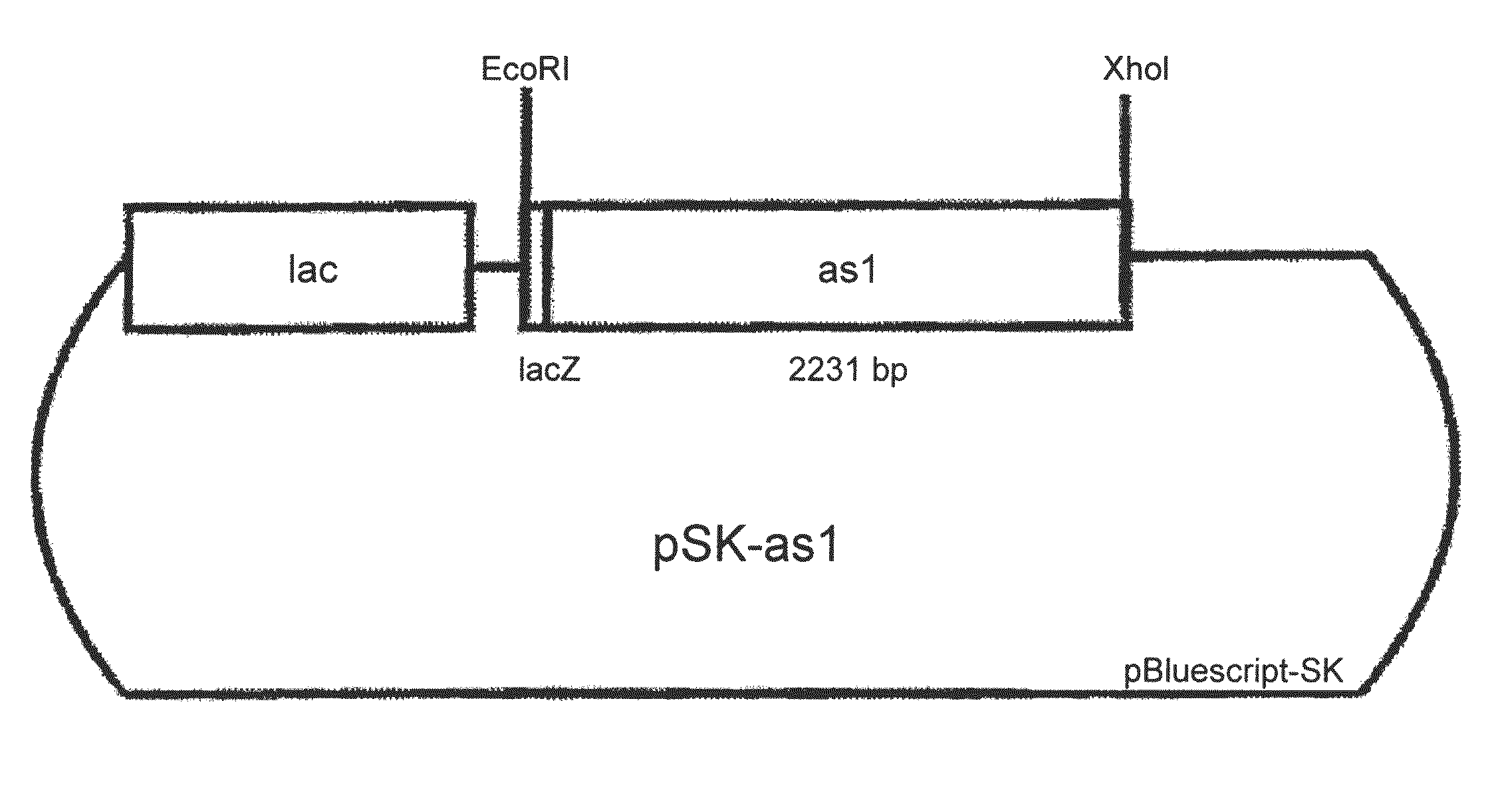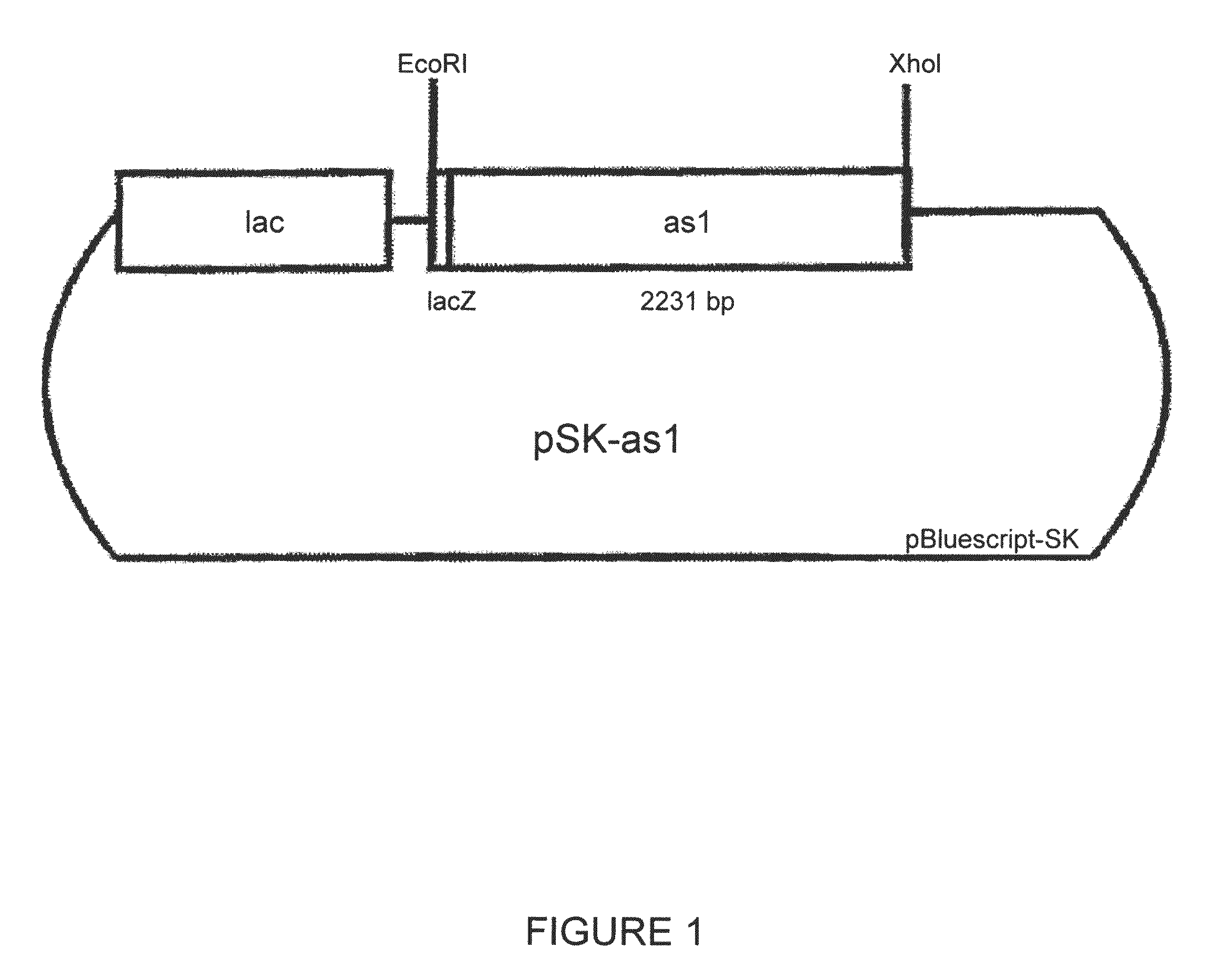Nucleic acid molecules encoding enzymes having fructosyltransferase activity, and their use
a technology of fructosyltransferase and nucleic acid, which is applied in the field of nucleic acid molecules encoding polypeptides, can solve the problems of inability to economically utilize transgenic plants, inability to obtain inulin that can be obtained from transgenic plants, and low yield, and achieves positive effects on health
- Summary
- Abstract
- Description
- Claims
- Application Information
AI Technical Summary
Benefits of technology
Problems solved by technology
Method used
Image
Examples
example 1
[0122]Purification of the af1-SST from Aspergillus sydowi
[0123]Aspergillus sydowi IAM 2544 was grown on a culture medium that contained 2% malt extract, 0.5% peptone and 2% sucrose. The medium was solidified by adding 2% agar. Spores were plated and the culture was maintained at 25° C. until the plates were completely dried. Conidia were harvested from the plates and dissolved in 50 mM sodium phosphate pH 6.0. ysis of the conidia was performed by three passages trough a “French Pressure Cell”.
[0124]For purification, the homogenate was adsorbed onto Sepharose Q. Bound protein was eluted with a linear gradient of 0 to 1000 mM KCI. Sucrolytically active fractions were obtained between 500 and 700 mM KCI. These fractions were pooled and dialyzed against sodium phosphate pH 6.0. For enriching the protein, it was again adsorbed onto Sepharose Q (bed volume 2 ml) and eluted in a volume of 10 ml.
[0125]The eluate was adjusted to 2 M ammonium sulfate and adsorbed to phenyl superose. Elution ...
example 2
Production of Constructs Containing Coding Regions of Fungal Fructosyltransferases for the Transformation of Various Pro- and Eukaryotic Host Cells.
[0129]For the transformation of various host cells with fungal fructosyltransferases a number of different constructs was prepared according to molecular-biological standard techniques (Sambrook et al., 1989, Cold Spring Harbor Laboratory Press). The constructs are shown in FIGS. 1 to 5. Specifically, the constructs were prepared as follows:[0130]pSK-as1 is a derivative of pas1 which was obtained as in vivo excision from a Lambda Zap II clone of the cDNA library ofAspergillus sydowi. pas1 contains the cDNA as EcoRI / XhoI fragment. pSK-as1 results from pas1 by cleavage of BamHI and SmaI, filling in the cohesive BamHI end and religating the vector. By removal of 4 nucleotides the coding region of as 1 is switched to the reading frame of the lacZ gene (FIG. 1).[0131]p112-as1 Into vector p112A1NE (see Riesmeier et al., EMBO J. 11 (1992), 4705...
example 3
Analysis of the Fructosyltransferase Activity of Transgenic Host Cells or Organisms Expressing Fungal Fructosyltransferases.
[0137]In vivo Synthesis of Inulin
[0138]Transgenic host cells or organisms which express fungal fructosyltransferases were cultured in media with 2% sucrose—unless it was plant tissue. In the case of Escherichia coli K12 as host organism, a functional cscB gene encoding the sucrose permease of E. coli was introduced as construct into the vector pACYC184. In the case of Saccharomyces cerevisiae the gene of the sucrose transporter of spinach was introduced into the vector p112AINE (Riesmeier et al., EMBO J. 11 (1992), 4705-4713). The cells were cultured for at least 24 hrs in the presence of sucrose, then harvested and broken up after washing in 50 mM sodium phosphate pH 6.0.
[0139]Plants expressing the fungal fructosyltransferases were grown in soil. After four weeks leaf and other tissue samples were taken and extracted in 1 ml water / g fresh weight in the presenc...
PUM
| Property | Measurement | Unit |
|---|---|---|
| nucleic acid | aaaaa | aaaaa |
| viscosity | aaaaa | aaaaa |
| degree of polymerization | aaaaa | aaaaa |
Abstract
Description
Claims
Application Information
 Login to View More
Login to View More - R&D
- Intellectual Property
- Life Sciences
- Materials
- Tech Scout
- Unparalleled Data Quality
- Higher Quality Content
- 60% Fewer Hallucinations
Browse by: Latest US Patents, China's latest patents, Technical Efficacy Thesaurus, Application Domain, Technology Topic, Popular Technical Reports.
© 2025 PatSnap. All rights reserved.Legal|Privacy policy|Modern Slavery Act Transparency Statement|Sitemap|About US| Contact US: help@patsnap.com



